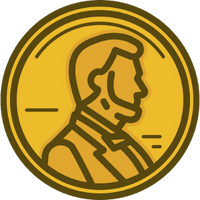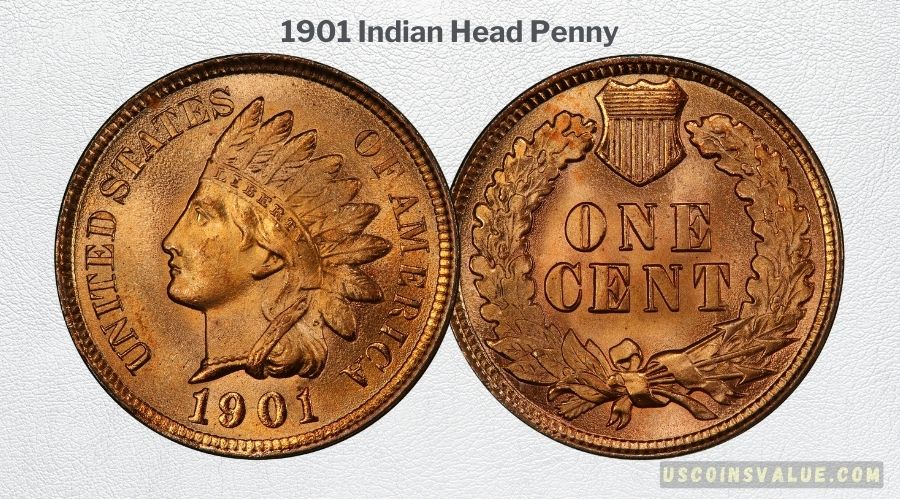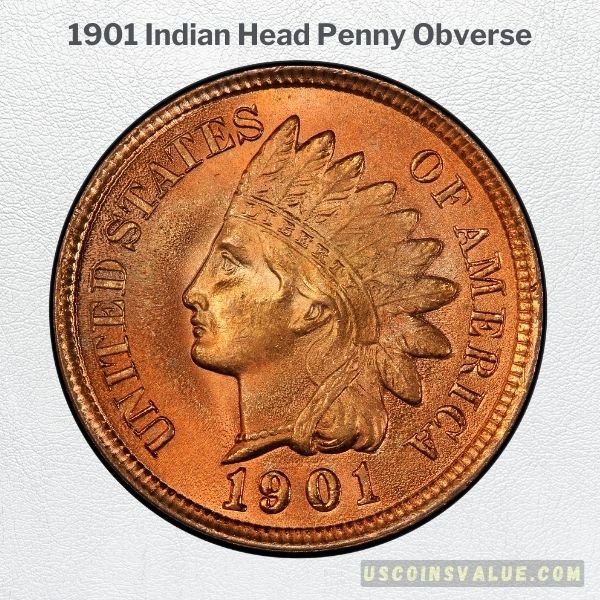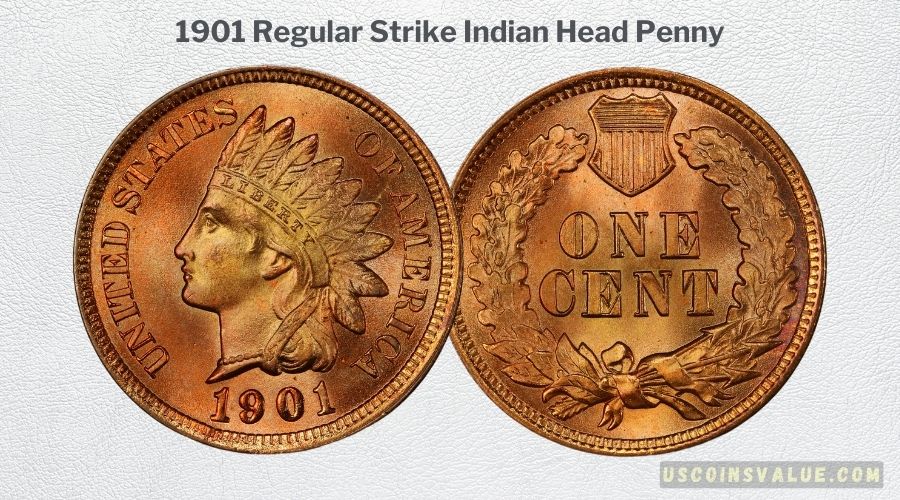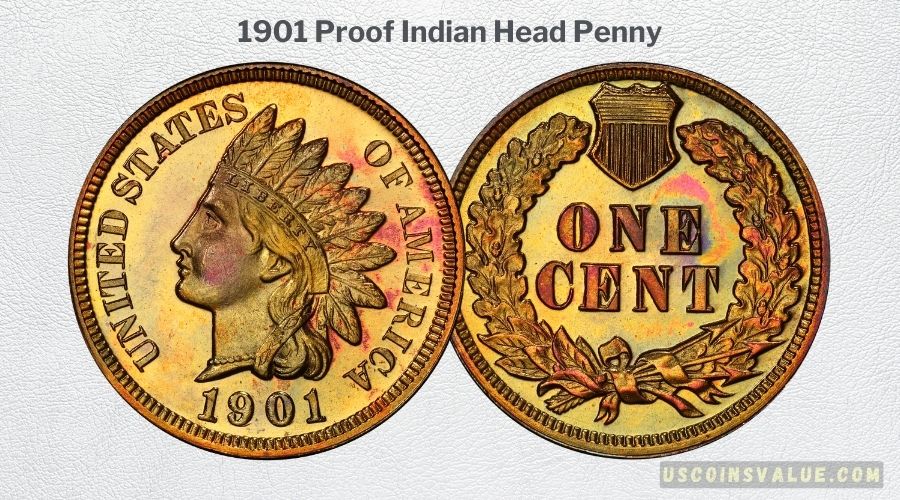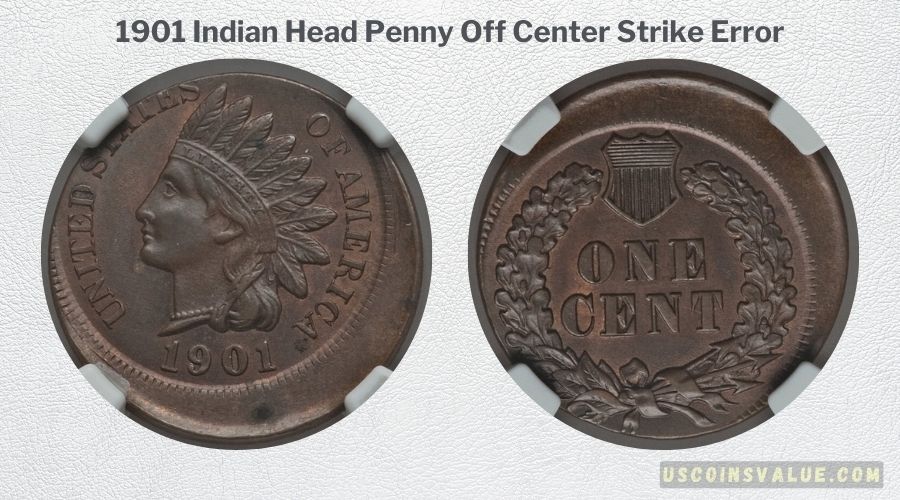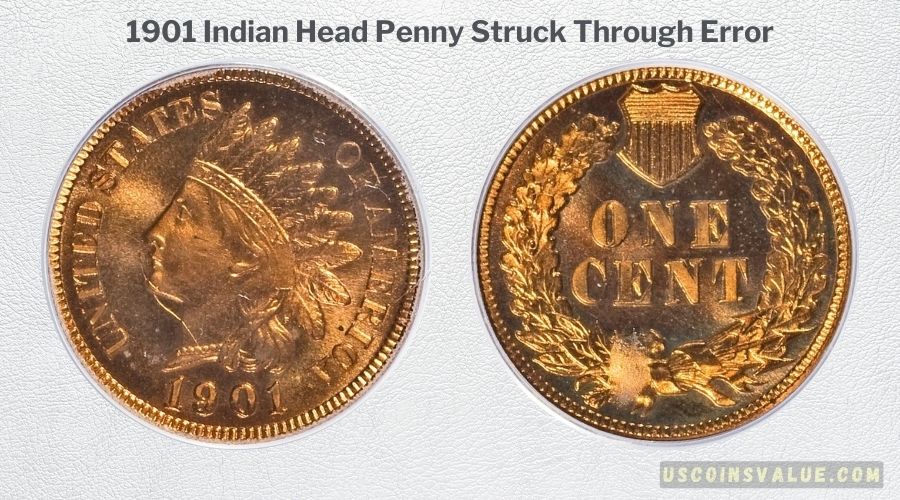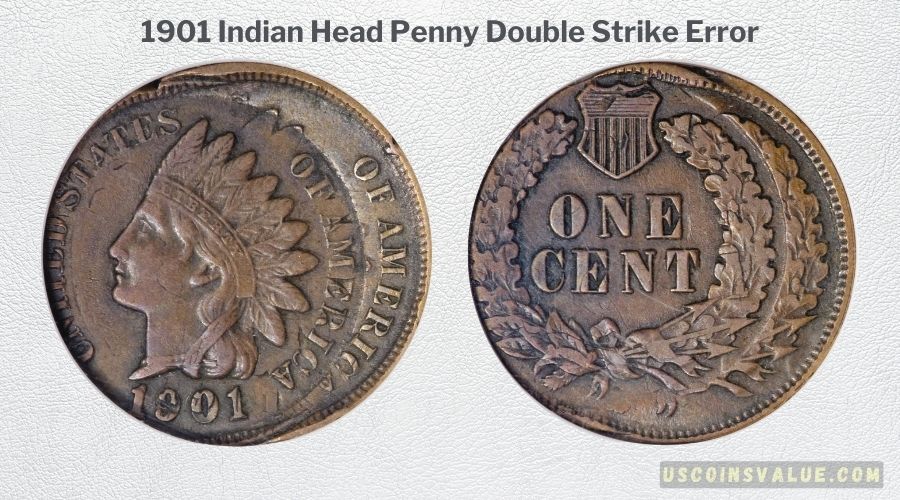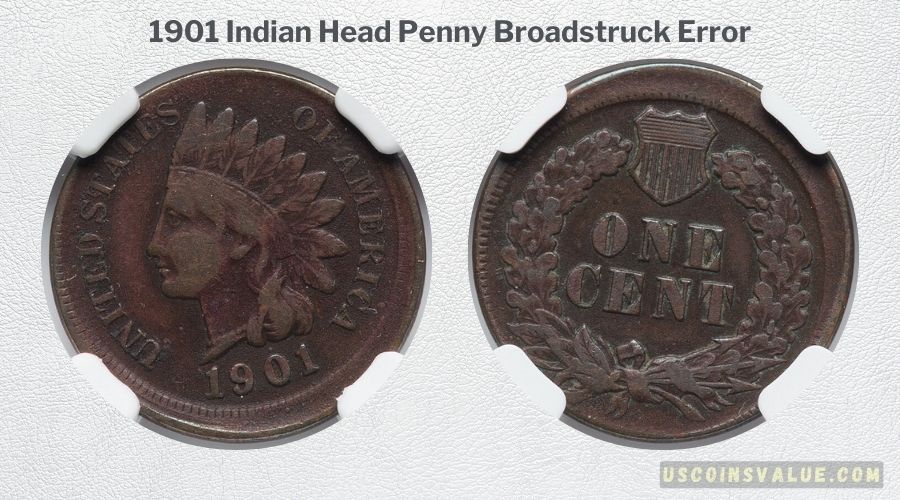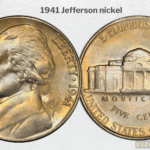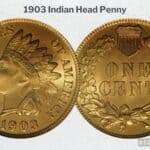Did you know you could make up to $33,600 on a 1901 MS67+ grade Indian Head Penny? Yes, old coins are worth that much. There’s a catch however.
For you to get maximum value for your Indian Head Penny, it has to be in top condition. So, don’t be too quick to dispose of your antique U.S. coins.
You can get an average 1901 Indian Head Penny for as low as $1.50.
Here’s a detailed review to help you know how to buy and sell this prized historical piece.
What is the Background of the 1901 Indian Head Penny?
James B. Longacre’s engraving of the Indian Head Chief was the leading coin design in America from 1859 until 1909. As one of the final sets of the series, the 1901 1C coin became a collector’s favorite.
Although 1901 saw almost 80 million in mintage of Indian Head cents, it’s still not as much as the other years like 1907. Also, finding a 1901 Indian Head Cent in top condition with all details still intact can be a chore. But when you find one, it is valued at several thousand dollars.
Before we discuss the monetary value of the 1901 Indian Head Penny, check out its features below.
The 1901 Indian Head Penny Features: What Does it Look Like?
- Series: Indian Head
- Year of Make: 1901
- Mintage: 79,609,158
- Mint Branch: Philadelphia
- Composition: 95% Copper, 5% Tin & Zinc
- Weight: 3.11g
- Diameter: 19 mm
- Edge: Plain
Obverse & Reverse Design: What Does the 1901 Indian Head Penny Look Like?
The obverse of the 1901 Indian Head Penny, has the engraving of an Indian Chief’s head facing left. Here, she adorns a traditional war bonnet, a crown of nine leaves. The engraving stops at her neck with a string of pearls and hair tendrils at the nape.
Other details on the 1901 Indian Head Penny obverse include:
- LIBERTY: “LIBERTY” is on the band of her crown of leaves.
- UNITED STATES OF AMERICA: “UNITED STATES” is on the curve in front of the chief’s face while “OF AMERICA” follows the curve behind her head.
- 1901: The production year is boldly engraved on the bottom under the chief’s neck.
- Mint Mark: None
The reverse side of the 1901 1C is different from its front. Although it has the same reeded motif on the circumference, the engravings say something else.
- ONE CENT: “ONE CENT” is engraved boldly at the center with “ONE” sitting above “CENT.”
- Coat of Arms: The US Coat of Arms shield is above “ONE” and at the center of a leaf wreath.
- Leaf Wreath: A wreath of leaves surrounds “ONE CENT” and stops on each side of the coat of Arms.
- Arrows in Ribbon: Three arrows facing the right are wrapped in a ribbon at the base of the wreath and under “CENT.”
What are the 1901 Indian Head Penny Varieties?
If you’ve noticed that there are different colors of the 1901 Indian Head Penny on sites like PCGS, Greysheet, NGC and Heritage, then you have an eye for spotting detail. You should also note that the 1901 Indian Head Penny is split into two variants — Regular Strike and Proof.
Before we get into the details, check out this table showing the difference between the Regular Strike and Proof Indian Head Pennies.
| 1901 (Indian Head) Varieties | Mintage |
| Regular Strike | 79,609,158 |
| Proof | 1,985 |
Regular Strike 1901 Indian Head Cent
With over 79 million pieces, the 1901 Indian Head Cents had three standard colors – Red (RD), Red & Brown (RB), and Brown (BN) with the same bronze composite of 95% Copper, 5% Tin & Zinc.
The Brown (BN) 1901 1C is the dullest of the three because of its sandy tone. It looks like bronze in its Mint State with precise details on the obverse and reverse. With the Red (RD), you’ll get an earthy clay red color with bronze blotches from wear and tear.
Finally, the third color, Red & Brown (RB), combines the red and brown colors on one coin. The patinas fade into each other, so it’s not a case of two-colored sides. It often shows as a sunny red-orange with hints of bronzed brown.
Proof 1901 Indian Head Cents
The 1,985 Proof 1901 Indian Head Pennies made in the Philadelphia Mint weren’t meant for circulation. They were sample pieces made for collectors and as prototypes of the regular strike coins that entered circulation.
Proof coins came in the typical red, brown, and red & brown colors like the regular strike 1901 Indian Head coins and a unique Cameo design with different production methods. For this reason, CAM Proof coins are even rarer.
What’s the Current Value of the 1901 Indian Head Penny?
The different 1901 Indian Head coins in circulation today, do not have a uniform value in the coin market. That’s a result of multiple factors, including the grade and color. Some designs are rarer to access, increasing demand and value.
As a general rule, for regular strike 1901 Indian Head cents, the RD variant is the most valuable, followed by the RB, then BN. For Proof 1901 1C coins, the CAM variant in PR67+ is the most valued. Then, the RD, RB, and BN are in that order.
You’ll notice this table doesn’t contain current values for MS68 or PR68 graded 1901 Indian Head Pennies. That’s not a mistake. The last recorded sales of a PR68 1901 1C Proof coin was in 2006. They raked in $17,250 and $9,775.
Here’s a table showing the current market rate for trading a 1901 Indian Head Penny.
| 1901 Indian Head Penny Grades (MS, PR) | 1901 Indian Head Penny Regular Strike (BN, RB, RD) | 1901 Indian Head Penny Proof (BN, RB, RD, CAM) |
| 60 | $45 – $60 | $140 – $235 |
| 61 | $50 – $85 | $150 – $250 |
| 62 | $75 – $110 | $200 – $300 |
| 63 | $100 – $200 | $300 – $450 |
| 64 | $140 – $325 | $340 – $850 |
| 65 | $185 – $825 | $550 – $5,000 |
| 66 | $600 – $2,650 | $1,050 – $17,500 |
| 67 | $1,850 – $33,500 | $2,150 – $50,000 |
The lowest values apply to BN 1901 Indian Head Coins while the highest values are for the RD (regular strike) and RD, CAM (proof) coins.
1901 Regular Strike Indian Head Penny
All three colors of the regular strike variant of the 1901 Indian Head Penny are collectible, but the RD version will most likely make you thousands of dollars at auction. Its value will increase if it’s graded between MS66 – MS67.
The year 2021 marked the record sale of a 1901 Indian Head Cent by Heritage Auctions for $33,600. This wasalmost $4,000 more than Legend Rare Coin Auctions sold a similar grade the previous year. This year however, Heritage Auctions sold another MS67+RD 1901 1C coin for $21,600, making it the third-highest sale ever for the 1901 Indian regular strike Indian Head Penny.
You should also know that sometimes two firms can collaborate to sell a coin, especially during an auction. It happened in 2021 with Stack’s Bowers and Heritage Auctions.
Don’t let the large figures scare you as a new collector. You can still cop a 1901 Indian Head Penny for as low as $1.50, but it’ll be in poor grade. If you search well, you may find a Mint State 1901 Indian Head coin in grade 60 for $35 or 60+ for $45 per NGC Coin.
| Grade | Highest Price & Sale Date | Firm |
| MS67+, RD | $33,600 (2021) | Heritage Auctions |
| MS67+, RD | $30,550 (2020) | Legend Rare Coin Auctions |
| MS67+, RD | $21,600 (2023) | Heritage Auctions |
| MS67, RD | $9,106 (2022) | Legend Rare Coin Auctions |
| MS67, RD | $8,100 (2022) | Heritage Auctions |
Figures sourced from PCGS Auctions.
1901 Proof Indian Head Penny
This variant is highly collectible and valued because of the unique die system used in producing Proof coins and their limited supply. The highest-selling 1901 Indian Head Penny was a Proof CAM variant graded 67+. It sold for almost $50,000 in 2020.
Legend Rare Coin Auctions sold a PR66 CAM piece for $23,500 the previous year. Heritage Auctions dropped the hammer at $7,200 this year for a PR67 CAM 1901 1C coin. USA Coin Book estimates that a Proof 1901 1C coin can be worth at least $292.
| Grade | Highest Price & Sale Date | Firm |
| PR67+, CAM | $49,937.50 (2020) | Legend Rare Coin Auctions |
| PR66, CAM | $8,100 (2022) | Heritage Auctions |
| PR67, RB | $7,344 (2018) | Legend Rare Coin Auctions |
| PR67, RD | $7,200 (2023) | Heritage Auctions |
Figures are sourced from PCGS Auctions.
Common Errors You’ll Find in the 1901 Indian Head Penny
As many coins each minting facility produced yearly, it’s easy to see how some pieces came out with errors. Sometimes, the mistake could be from the machine, and other times it was human.
It was bad business then but has become a “goldmine” in today’s coin collector’s market. Because these errors were rare, the supply and demand were low, leading to its increased value. Here are some popular errors you’ll find on your coin.
- Off Center Strike Error
- Struck Through Error
- Double Strike Error
- Broadstruck Error
Off Center Strike
When a die isn’t properly placed on the planchet, it causes an off-center strike. The extent of the shift varies based on the error. It might be a slight 5% flaw or as wide as 80%.
Coins with off-center strike errors have large empty spaces on the field and partial engravings often on the corner.
- An MS64 BN 1901 Indian Head cent with a 15% off center strike sold for $493.50.
- In 2014, an MS62 BN 1901 Indian Head cent sold for $199.75.
- Heritage Auctions sold a 10% off center strike 1901 Indian Head cent with a scratched surface for $69 in 2011.
Struck Through Error
Strike-through errors occur when a foreign object enters the minting machine and obstructs the natural system. You’ll see the effects of the “Struck through” object left on the coin. This is common when the wrong die or composite is used during production.
A strike-through can happen on the obverse or reverse, depending on where the foreign object sits.
- In 2009, Heritage Auctions sold a 1901 Indian Cent with an obverse Struck through error for $345.
Double Strike Error
Every coin needs a single strike for perfect engravings, but when there’s a problem with the mechanism, you’ll need a second strike. When this happens, the coin gets stuck between dies instead of the routine ejection after a strike.
Hence, the double strike error always causes duplicated details.
- In 2005, a flip over double struck Indian Cent sold for $546.25.
- A double struck 1901 Indian Head cent sold for $747.50 in 2009.
Broadstruck Error
During production, coins have a “collar” that keeps them in place to ensure a perfect diameter. But when the retaining collar shifts, the planchet widens and causes a broad strike. So, coins with broadstruck error have engravings that are smaller than usual.
If you have a 1901 1C coin with this error, don’t stress. You can make a few dollars selling it at auction.
- In June, 2023, a Broadstruck 1901 1C Indian Head coin sold for $61.
- In 2007, another Broadstruck Indian Head Cent sold for less at $57.
Final Thoughts
The least-graded Proof 1901 Indian Head Penny is worth more than a regular strike variant. So, if you’re collecting coins as a form of financial investment, it’s best to target Proof coins. However, if you’re numismatic, you can start anywhere.
We sourced the prize details from reputable companies known for valuing and trading vintage and antique coins. It’s always best to consult these verified companies to get the best services and avoid fraudsters.
